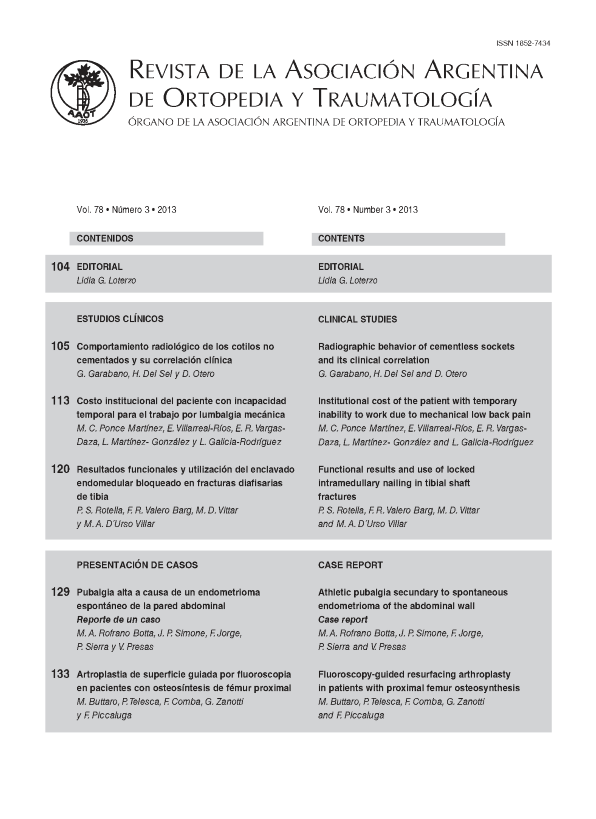Resultados funcionales y utilización del enclavado endomedular bloqueado en fracturas de tibia. [Functional results and use of locked intramedullary nailing in tibial shaft fractures]
Contenido principal del artículo
Resumen
Descargas
Métricas
Detalles del artículo

Esta obra está bajo licencia internacional Creative Commons Reconocimiento-NoComercial-CompartirIgual 4.0.
La aceptación del manuscrito por parte de la revista implica la no presentación simultánea a otras revistas u órganos editoriales. La RAAOT se encuentra bajo la licencia Creative Commons 4.0. Atribución-NoComercial-CompartirIgual (http://creativecommons.org/licenses/by-nc-sa/4.0/deed.es). Se puede compartir, copiar, distribuir, alterar, transformar, generar una obra derivada, ejecutar y comunicar públicamente la obra, siempre que: a) se cite la autoría y la fuente original de su publicación (revista, editorial y URL de la obra); b) no se usen para fines comerciales; c) se mantengan los mismos términos de la licencia.
En caso de que el manuscrito sea aprobado para su próxima publicación, los autores conservan los derechos de autor y cederán a la revista los derechos de la publicación, edición, reproducción, distribución, exhibición y comunicación a nivel nacional e internacional en las diferentes bases de datos, repositorios y portales.
Se deja constancia que el referido artículo es inédito y que no está en espera de impresión en alguna otra publicación nacional o extranjera.
Por la presente, acepta/n las modificaciones que sean necesarias, sugeridas en la revisión por los pares (referato), para adaptar el trabajo al estilo y modalidad de publicación de la Revista.
Citas
2. Hopper GK, Kedell RG, Penny ID. Conservative management or closed nailing for tibial shaft fractures. A randomized prospective trial. J Bone Joint Surg Br 1991;73:83-5.
3. Alho A, Benterud JG, Hogevold HE, Ekeland A, Stromsoe K. Comparison of functional bracing and locked intramedullary nailing in treatment of displaced tibial fractures. Clin Orthop 1992;277:243-50.
4. Henley MB, Chapman JR, Agel J, Harvey EJ, Whorton AM, Swiontkowski MF. Treatment of type IIIA and IIIB open fractures of the tibial shaft: Prospective comparison of unreamed interlocking intramedullary nails and half-pin external fixators. J Orthop Trauma 1998;12(1):1-7.
5. Duwelius P, Schmidt A, Rubinstein R, Green J. Nonreamed interlocked intramedullary tibial nailing. Clin Orthop 1995;315:104-13.
6. Keating J, O Brien P, Blachut P, Meek R, Broekhuyse H. Reamed interlocking intramedullary nailing of open fractures of the tibia. Clin Orthop 1997;338:182-91.
7. Brown C, Christie J, Mc Queen M. Closed intramedullary tibial nailing. J Bone Joint Surg Br 1990;72:605-11.
8. Sanders R, Jersinovich I, Anglen J, Di Pasquale T, Herscovici D. The treatment of open tibial shaft fractures using an interlocked
intramedullary nail without reaming. J Orthop Trauma 1994;6:504-10.
9. Chi-Chan Wu, Chun-Hsiung Shih. Segmental tibial fractures treated with interlocking nailing. J Orthop Trauma 1993;5:468-72.
10. Ching-Kuei Huang, Wei-Ming Chen, Tain Hsiung Chen, Wai-Hee Lo. Segmental tibial fractures treated with interlocking nails. Acta Orthop Scand 1997;68(6):563-6.
11. Bone L, Johnson K. Treatment of tibial fractures by reaming and intramedullary nailing. J Bone Joint Surg Am 1986;68:877-86.
12. Kohlprath R, Assal M, Uckay I, Holzer N, Hoffmever P, Suva D. Open fractures of the tibia in the adult: surgical treatment and complications. Rev Med Suisse 2011;7(322): 2482, 2484-8.
13. Dickson K, Hoffman W, Delgado E, Contreras D. Unreamed rod with early wound closure for grade IIIA and IIIB open tibial fractures: analysis of 40 consecutive patients. Orthopedics 1998;21:531-5.
14. Whittle A, Rusell T, Taylor Ch, Lavelle D. Treatment of open fractures of the tibial shaft with the use of interlocking nailing without reaming. J Bone Joint Surg Am 1992;74:1162-71.
15. Gregory P, Sanders R. The treatment of closed, unstable tibial shaft fractures with unreamed interlocking nails. Clin Orthop 1995;315:48-55.
16. Krettek C, Schandelmaier P, Tscherne H. Nonreamed interlocking nailing of closed tibial fractures with severe soft tissue injury. Clin Orthop 1995;315:34-47.
17. Blachut PA, O Brien PJ, Meek RN, Broekhuyse HM. Interlocking intramedullary nailing with and without reaming for the treatment of closed fractures of the tibial shaft. J Bone Joint Surg Am 1997;79:640-6.
18. Court-Brown CM, Will E, Christie J, Mc Queen MM. Reamed or unreamed nailing for closed tibial shaft fractures. A prospective study in Tscherne C1 fractures. J Bone Joint Surg Br 1996;78:580-3.
19. Hart A, Moerman J, Groote W, Vandekerckhove B, Verbeke R, Verdonk R, Claessens H. Treatment of tibial shaft fractures by interlocking mailing. Acta Orthopaedica Belgica 1993;59:381-9.
20. Galim P, Rosenblatt Y, Parnes N, Dekel S, Steinberg L. Intramedullary fixation of tibial shaft fractures using an expandable
nail. Clin Orthop Relat Res 2006;455:234-40.
21. Muller C, Strohm P, Morakis P, Pfister U. Intramedullary nailing of the tibia: Current status of primary unreamed nailing. Part 1: Results for closed fractures. Injury 1999;30(Suppl 3):37-43.
22. Sarmiento A, Sharpe FE, Ebramzadeh E, Normand P, Shankwiler J. Factors influencing the outcome of closed tibial fractures treated with functional bracing. Clin Orthop 1995;315:8-24.
23. Bonatus T, Olson S, Lee S, Chapman M. Nonreamed locking intramedullary nailing for open fractures of the tibia. Clin Orthop
1997;339:58-64.
24. Lang G. Orthopaedic Knowledge Update, American Academy of Orthopaedic Surgeons; 2000; cap 17: 177-190.
25. Wiss D, Stetson W. Unstable fractures of the tibia treated with a reamed intramedullary interlocking nail. Clin Orthop 1995;315:56-63.
26. Muller M, Allgower M, Schneider R, Willeneger H. Manual de Osteosíntesis. Técnica AO. Barcelona, España: Springer-Verlag;
1992.

